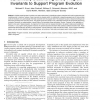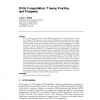268 search results - page 10 / 54 » Using Second Life in Programming's Communities of Practice |
ICSE
2009
IEEE-ACM
14 years 7 months ago
2009
IEEE-ACM
Automatic repair of programs has been a longstanding goal in software engineering, yet debugging remains a largely manual process. We introduce a fully automated method for locati...
CHES
2010
Springer
13 years 7 months ago
2010
Springer
The power of side-channel leakage attacks on cryptographic implementations is evident. Today's practical defenses are typically attack-specific countermeasures against certain...
ICASSP
2008
IEEE
14 years 1 months ago
2008
IEEE
We recently reported a criterion for blind separation of non-negative sources, using a new concept called convex analysis for mixtures of non-negative sources (CAMNS). Under some ...
ICSE
1999
IEEE-ACM
13 years 11 months ago
1999
IEEE-ACM
ÐExplicitly stated program invariants can help programmers by identifying program properties that must be preserved when modifying code. In practice, however, these invariants are...
EC
1998
13 years 6 months ago
1998
L. M. Adleman launched the field of DNA computing with a demonstration in 1994 that strands of DNA could be used to solve the Hamiltonian path problem for a simple graph. He also...


